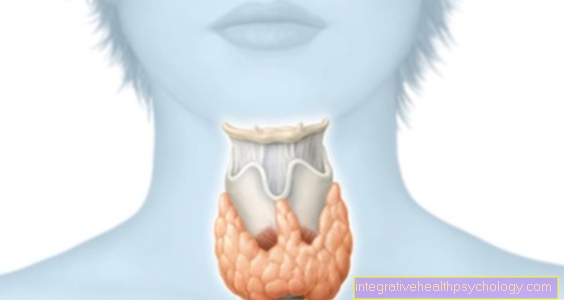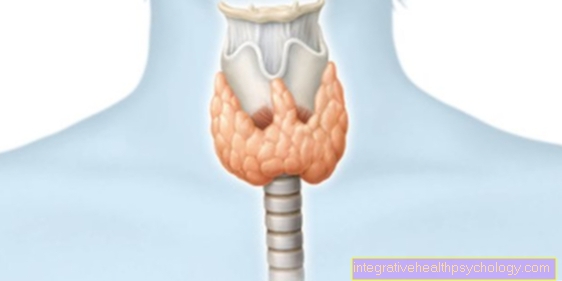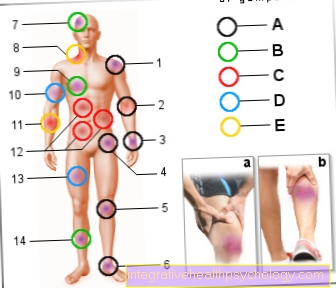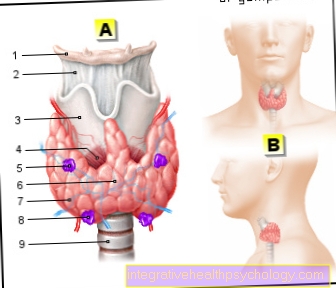Symptoms of a sore throat
introduction
There are characteristic symptoms of acute and chronic pharyngitis, some of which overlap.
When the throat is inflamed (pharyngitis), the mucous membrane in the throat is inflamed. The mucous membrane of the throat can become acutely inflamed, for example as a side effect of a cold or as part of a flu-like infection.
Chronic throat infections can be the result of excessive nicotine consumption or radiation therapy.

Typical symptoms of a sore throat
- Itching and burning in the throat
- Sore throat
- Possibly. The sore throat radiates into the ears
- Pain when swallowing
- Dry, rough feeling in the throat
- Reddened lining of the throat
- Possibly. mucous lining of the throat
- Lump feeling in the throat
- hoarseness
- Feeling thirsty
- cough
- fever
- a headache
- Increased salivation
Sore throat
With a sore throat, there is often a scratching and burning sensation in the throat at the beginning of the inflammation.
The scratching usually develops into pronounced pain in the throat and throat. Often the sore throat is accompanied by pain when swallowing.
In addition, the sore throat can be accompanied by hoarseness and, depending on the cause of the sore throat, symptoms such as cough, runny nose, headache or fever can occur.
The sore throat occurs due to inflammatory processes in the throat and throat, which are often caused by viruses or bacteria. The mucous membranes in the throat turn red, swell and cause pain.
Larynx pain
As part of a sore throat, clearly noticeable larynx pain can occur in addition to the sore throat.
Not everyone can localize a larynx pain well, and this pain is often equated with a sore throat. The larynx can become inflamed and cause pain if the sore throat spreads.
If one suffers from pain in the larynx area, there is also hoarseness in most cases. Hoarseness is a characteristic symptom of laryngitis.
Are you afraid of laryngitis? Find out more about the symptoms of laryngitis on the following page: Symptoms of laryngitis
a headache
Headache can occur as a concomitant symptom of an acute sore throat and manifest itself very differently. The headache starts either slowly or suddenly. They can be dull, piercing, very violent, or barely noticeable. The headache can get better at rest or lying down, or worse when moving.
You can read detailed information about this symptom here: Headache with a cold
Increased salivation
If the throat is severely swollen and inflamed due to a sore throat, there may be an increased flow of saliva (hypersalivation). What this means is that the salivary glands in the mouth produce excessive amounts of saliva.
A healthy person produces 1.5 liters of saliva a day. Increased salivation is any amount well over 1.5 liters a day. The excessive flow of saliva can be accompanied by uncontrolled flow of saliva from the mouth (sialorrhea). Sialorrhea can manifest itself in the form of "drooling" or wet pronunciation.
difficulties swallowing
Typical symptoms of swallowing disorders are a feeling of lump in the throat, increased saliva production and difficulty or pain in eating.
Sometimes a gag reflex occurs while swallowing, gagging of food that has already been swallowed, or coughing while eating.
Many different (physical) causes can cause swallowing difficulties; inflammation of the throat and tonsillitis are common reasons.
In inflammatory pharyngitis, pain is often the main difficulty in swallowing. The inflamed lining of the throat becomes irritated when the food is swallowed, which causes pain. Many people tend to have soups when they have a sore throat, as they can be taken more easily and with less pain.
pus
A sore throat often occurs with a flu-like infection or a cold. Viruses are therefore mainly responsible for the inflammation of the pharynx. More rarely, bacteria are the cause of pharyngitis. A lot of bacterial throat infections are caused by streptococci.
A bacterial inflammation can be recognized by the accumulation of pus in the throat, these are visible white-yellowish deposits (pus sticks). Bacterial throat infections are usually more serious than viral and are accompanied by a fever. If you find pus in the throat, you should see an ear, nose and throat doctor.
Do you have pus in your throat? Further information on bacterial throat infections with pus can be found here: Pus in the throat
fever
Fever can be a symptom of an acute sore throat. Fever occurs in the context of a sore throat, especially when, in addition to viruses, bacteria also colonize the inflamed pharynx. One speaks here of a bacterial superinfection.
A fever is an increase in body temperature of 38 ° C or more. The body increases the body temperature to a newly set “target value” in order to ward off harmful influences. Since fever can be dangerous for those affected, a doctor should be consulted in the event of an acute sore throat and the fever should be reduced.
mucus
Mucus is common in chronic pharyngitis. Those affected have a dry throat, a lumpy feeling in the throat and usually a dry cough. Coughing loosens the tough phlegm.
Expectorants and lots of tea will help reduce the sticky phlegm. In order to permanently alleviate the formation of mucus and symptoms such as dry cough, it is important to find out the cause of the throat inflammation and to treat it specifically. When the mucous membrane of the throat heals and can do its job again, the production of mucus also decreases.
What are the typical symptoms in a toddler / child?
Children suffer from throat infections more often than adults. One of the reasons for this is that, in children, the tonsils are the central organ of the immune system and are involved in inflammation. In the case of an acute inflammation of the pharynx, the symptoms usually appear very suddenly.
Children typically have a severe sore throat. The throat feels dry and itchy. Difficulty swallowing occurs, especially pain during the swallowing process. This leads to the fact that children refuse to eat. This can be an indication of a disease, especially in small children, who cannot express their symptoms in any other way.
The mucous membrane of the throat is reddened and possibly covered with pus. The inflammation can be accompanied by a cough and runny nose or even inflammation of the sinuses (sinusitis). The lymph nodes in the jaw area are often swollen palpably. Children can develop a fever and headache as part of the sore throat. Sometimes children also suffer from non-specific symptoms such as nausea and abdominal pain.
What are the typical symptoms of chronic sore throat?
The symptoms of chronic pharyngitis do not appear suddenly, but over a long period of time. Some of the symptoms are less pronounced than with acute pharyngitis, but they are still stressful.
People with chronic sore throat often describe a dry, sore throat feeling. Those affected can get a lump feeling in the throat, which can develop into a pronounced feeling of foreign bodies in the throat (globus syndrome). You often have the urge to clear your throat and typical dry cough. A thick mucus is often secreted with the cough. Chronic inflammation of the throat can also cause difficulty swallowing and gag reflex.
The discomfort in the throat and the dry cough can cause serious sleep problems. Chronic sore throat can be triggered by certain triggers such as tobacco smoke, dry air, or chemicals. It is therefore important to find the cause of the complaints and to avoid them if possible.
You can find further information on chronic pharyngitis here: chronic sore throat





























